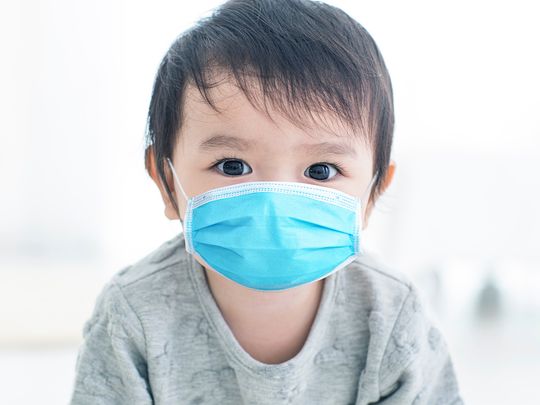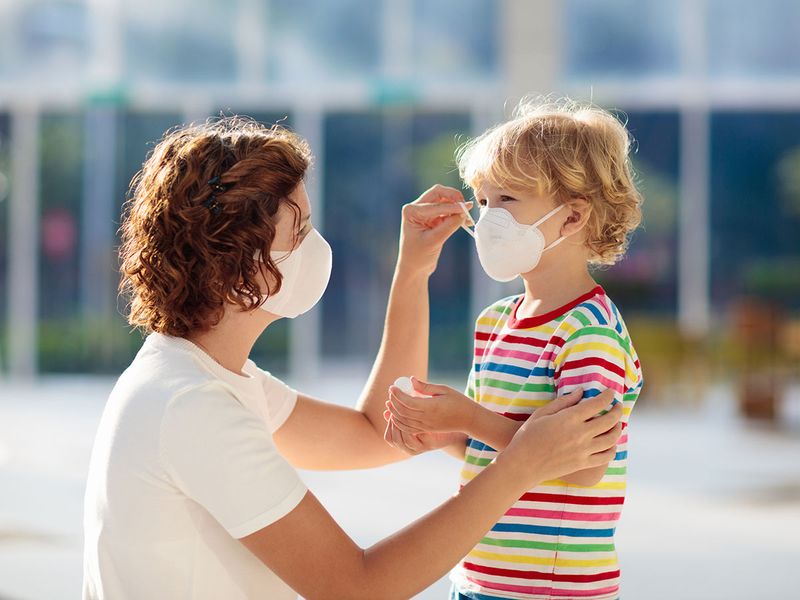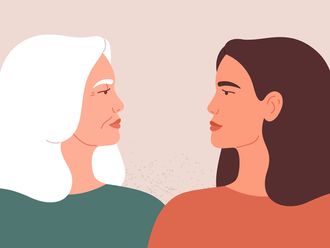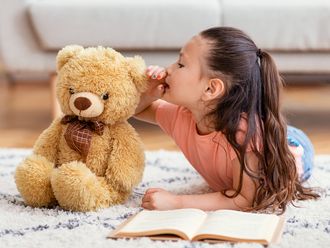
There were many sighs of relief when the Dubai government announced that children under the age of six no longer need to wear masks in public in the emirate; not least because global health institutions like the World Health Organisation and the Center for Disease Control and Prevention emphatically caution against putting masks on the faces of children and babies under the age of two years due to the suffocation risk.
However, there have also been murmurings of concern, since those same global organisations have made it clear that - along with frequent, thorough handwashing - wearing a face mask is one of the best lines of defense against the spread of the coronavirus that causes Covid-19.
In fact, since children seem to exhibit milder symptoms of the virus but could potentially be just as infectious, it may be even more important that they wear masks in order to reduce the risk of them transmitting it to others. “Kids are much more likely to be asymptomatic carriers and therefore may allow for more transmission since it is difficult to tell that they have the infection,” says Dr Frank Esper, pediatric infectious diseases specialist at Cleveland Clinic Children’s. “In general, [the medical community] feels that children should be wearing face masks just like adults. We believe that children are as much at risk for acquiring the infection as well as spreading the infection as adults.”
Of course toddlers and younger children may not tolerate wearing a mask, says Dr Esper, in which case maintaining social distancing remains crucial – as it is for all of us, regardless of whether we are wearing a mask or not. “It is critical to emphasize that face masks alone are not enough to prevent spread or protective against infection,” says Dr Esper. “Maintaining two-metre social distancing and avoiding public areas remain important to slowing the spread of the virus.”

However, if your child is going to be in public and is six years old or over, or is more than two years old and might tolerate wearing a face mask, then here’s how to do it happily and hygienically:
Which mask to use?
Although surgical-grade N95 respirators are the most effective masks to wear and have been shown to block 97% of viral particles when worn correctly, these are expensive to make, require specialized training to fit properly and are limited in supply, so should be reserved for healthcare workers.
Surgical, single-use masks are around 62-65% effective in blocking viral particles and the UAE has not so far faced the shortages that many other countries have suffered. However, it can be hard to find them in the paediatric size (and a close fit is the most important aspect of face-covering efficacy), and there is also an environmental concern: many of them are made from layers of plastic and are designed to be disposed of after one use. A UK study found that if every person in the UK used one single-use mask every day for the year, an extra 66,000 tonnes of plastic waste would be created.
Cloth Face Masks may seem like they are only for fashion, but in fact the CDC recommends that people use cloth face masks to protect against Covid-19. However, not all cloth face masks as created equal. A US study analysed the effectiveness of 400 different cloth face masks and found that they varied from being better than surgical masks, blocking out 79% of infectious particles, to being almost useless, blocking out only 1% of particles.
Are cloth masks really effective?
There have been many enterprising local businesses that have designed cloth face coverings in child-friendly designs to make it easier to convince children to wear them. However, the material that is used is very important; studies have shown their efficacy can range from 79% effective to just 1% depending on what it is made of. Generally, the tighter the weave of the fabric, the more effective they will be (hold your mask up to the light – can you see through it? If so you may want to use one with a tighter-weave fabric).
Many of the child-friendly face masks include a pocket, so that you can insert a surgical mask for an extra layer of protection, and one mother has even designed Superhero Shields, which include a kid-friendly visor on top of the face mask.
However, Cleveland Clinic Children’s Dr Esper emphasies that, “Infants and toddlers should not wear masks that as they could be a choking hazard. In general, we do not recommend anyone put masks on who are not able to remove the mask by themselves. Those children who have underlying respiratory problems may also need to refrain from using masks, especially if the mask exacerbates their breathing problems.”
Best practice for children and face masks
Dr Fiona Rennie, Specialist Family Medicine doctor at Genesis Clinic Dubai says: “Children are best kept at home as much as possible and children who are sick with symptoms such as fever, cough, runny nose, gastrointestinal symptoms should not leave the home until symptom-free to prevent spreading to others.
“If you suspect your child has COVID19 then call a medical facility for advice rather than taking them straight to a clinic.”
The two main ways of contracting COVID 19 are by direct contact and aerosol contact. “A child is at risk by touching a contaminated surface and then touching their face and also by being in close proximity of aerosol virus,” adds Dr Rennie. “All of this is compounded by the difficulty in keeping a mask on without them removing it or touching their face.”
If you do need to take your child out of the home Genesis Clinic’s Dr Rennie recommends the following:
- Explain in language they will understand why they need to wear a mask.
- Also try to make them understand that once the mask is on that they need to try not to touch it or touch their face.
- Masks (cloth or paper) should fit well, cover the nose and mouth securely and stretch from ear to ear. When home, remove from behind and avoid touching the outer surface, which is potentially contaminated.
- Wash cloth face coverings after each wearing.
- Dispose of paper masks after each wearing and do not re-use
- If under two years of age do not use cloth face coverings due to the risk of choking or strangulation
- If you choose not to use a mask or cloth covering for your child, then ensure they are at least 6 feet away from others at all times and do not touch surfaces, play equipment etc.
- If your child is considered high-risk due to a medical condition, then it is important to seek advice from a medical professional as they will need special precautions
The Centers for Disease Control and Prevention (CDC) suggest the following strategies to help get a child to cover their nose and mouth:
- Look in the mirror with the face coverings on and talk about it.
- Put a cloth face covering on a favorite stuffed animal.
- Decorate them so they're more personalized and fun.
- Show your child pictures of other children wearing them.
- Draw one on their favorite book character.
- Practice wearing the face covering at home to help your child get used to it.
Cloth Face Coverings Should:
- Fit snugly but comfortably against the side of the face
- Be secured with ties or ear loops
- Include multiple layers of fabric
- Allow for breathing without restriction
- Be able to be laundered and machine dried without damage or change to shape
Read more:








